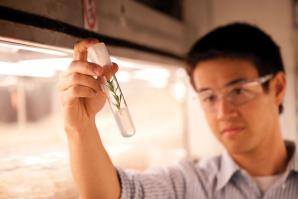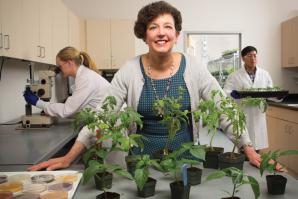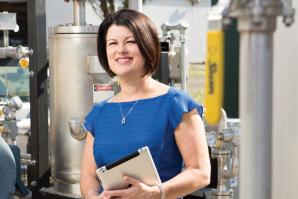In 2008, John Bissell co-founded Micromidas Inc., a West Sacramento biotech company that has developed a process to convert carbohydrate feedstocks like cardboard into higher-value chemicals, including renewable plastics. The company incorporated in 2009. Bissell, a UC Davis grad who also serves as CEO, was recently included in Forbes Magazine’s “30 Under 30,” a tally of the brightest stars in 15 different fields, and has helped raise more than $20 million in financing for his company.
What makes Micromidas stand out in industrial chemical technology?
“We produce a precursor to the plastic used in water bottles. I would say that our principle differentiating feature is the high yield of our chemistry. Many of the companies making chemicals from biological sources (e.g. wheat chaff, rice straw, wood chips, waste paper) either produce a gemisch of many different products or have a relatively low quantity of finished product per ton of material consumed. Our chemistry, however, produces only the desired product in a very efficient fashion.”
What was it like going out to the venture capital community looking to raise funds for a startup in the middle of a recession?
“It was tough. At one presentation, the president of Sequoia Capital stood up holding a stack of company portfolios that had been presented that day. He infamously told the group gathered there, ‘There is no money. You must survive on what you have. Presume there will be no more checks in the future.’ In March 2010, we finally closed our first significant round of funding ($3.6 million). Before that, we had a couple $100,000 investments from local investors. It was just enough to keep us going.”
Are you profitable right now?
“Technology advancements in the commodity chemicals market is the biggest thing in the industry right now. It has the biggest potential payoff. However, the challenge with commodity chemicals is that you can’t make money at a small scale. Paraxylene (a chemical essential to the process of manufacturing plastic bottles and polyester clothing) sells for about 50 cents to a buck a pound. When you factor in your margins, you’ve got to make a lot of it to make any money. It’s reasonable to project that you can make a dollar in revenue for every dollar invested, so we believe we need to build a $100-million plant.”
Where will the plant be located?
“It would be ideal if we could put it in Sacramento, but because of the realities of the market, that is not likely to happen. A lot of that has to do with the natural materials flow of the world. We need biomass and ethylene to produce our end product, paraxylene, for a specific set of customers throughout the world. It turns out, the majority of our targeted suppliers and customers are not located in California. The paraxylene is a polyester fabric that is commonly used to produce plastic bottles. They are produced all over the world, but in the U.S. tend to be congregated in the Gulf Coast and the Southeast. Internationally, they are heavily produced in Southeast Asia, northern China, Japan and some parts of southern Europe.”
Is it true that the technology your company is currently based on is different from the original VC-funded technology?
“Yes. But that’s pretty common in the world of VC-backed technology. It’s what we call pivoting. It’s not a bait-and-switch. After about three months, we stumbled across the new technology. We said, ‘God, this is much better, more efficient and cost effective.’ We spent three months testing it to make sure we weren’t grasping at straws. And then we made the jump in a very calculated fashion. Our investors were kept apprised of the pivot we were considering. We made the switch in the middle of 2010. It wasn’t a long time into the process, but it sure felt like a long time.”
How well did the Green Technology Entrepreneurship Academy at UC Davis prepare you and your partners for the competitive fundraising effort?
“It meant a lot to me. I wasn’t exactly a veteran fundraiser. I learned a lot of perseverance. I also learned the value of listening. A lot of entrepreneurs will go into pitches with an attitude of expertise and are resistant to listening to critics. They believe they really do know more than anybody else about that particular product or business model. Now, some experienced professionals, like Pam Marrone (Marrone Bio Innovations), can get away with that approach. She really does know more than anyone else in her sector. But not me. I tried very hard to listen to what the investors were saying that was good or bad about the viability of taking our product to market.
Sick of missing out? Sign up for our weekly newsletter highlighting our most popular content. Or take it a step further and become a print subscriber — it’s both glossy and affordable!
Recommended For You

Social Network
How crowdfunding connects strangers — and your business – to money
“Small Market, Big Heart” tells the story of the Sacramento Kings and their fans’ fight to hold onto the team. But the 80-minute documentary — packed with NBA archive footage and interviews with Kings’ executives, local politicians and sports entertainment personalities — isn’t from the NBA offices or an established production company.

Genetically Engineered Industry
The Capital Region holds promise for agricultural technology
A few months after the 2002 launch of Arcadia Biosciences Inc. in Phoenix, CEO Eric Rey insisted the company move to California. Not to Silicon Valley, but to Davis.





